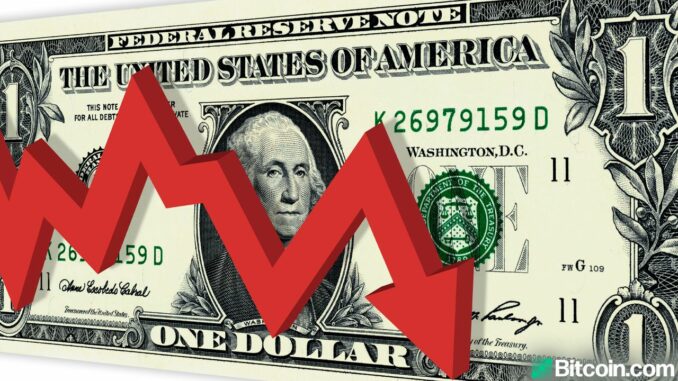Decline of U.S. dollar dominance – what it means for workers
The U.S. sells more than $175 billion in military weapons every year; yet for decades, its greatest weapon has been the U.S. dollar’s global dominance.
Imperialist wars and U.S. dollar hegemony go hand in hand. To prevent them from developing alternative currencies to the dollar, the U.S. military invaded Iraq in 2003 and attacked Libya in 201l, murdering both countries’ leaders. The dominance of the dollar also impacted Venezuela’s ability to benefit from the sale of its vast oil resources, driving that country deeper into poverty.

Through its control of the International Monetary Fund and the World Bank, the U.S. has set political conditions for countries to receive monetary support. Most often this has involved adopting neoliberal policies and opening their markets for Western corporations to super exploit their workers. An example of how these global financiers operate can be seen in the 2001 film “Life and Debt,” which documents how high-interest loans from the IMF destroyed Jamaica’s economy, leaving it permanently indebted to and dependent on the West.
The U.S. dollar became the dominant global reserve currency after then-President Richard Nixon took the dollar off the gold standard in 1971. Since then the U.S. has used that position to force countries to do its bidding, more frequently freezing or even confiscating a country’s assets, as it has done with Iran and Venezuela.
Using the excuse of the U.S./NATO war against Russia in Ukraine, the U.S. government imposed sanctions on Russia in February 2022. But it may have gone too far when it froze the Central Bank of Russia’s $300 billion in foreign exchange and gold reserves on March 26 of that year, for that resulted in a global backlash as countries looked for viable alternative currencies to the dollar.
Along with the economic sanctions imposed on Russia, Washington has used the war in Ukraine to promote the export of U.S. shale gas and oil as an alternative to Russian energy.
An initial sign of growing opposition from countries in the Global South was the result of the United Nations vote condemning Russia’s invasion of Ukraine in March 2022. While the resolution passed, abstainers included China, India, Iran, Iraq, Mozambique, Pakistan, Senegal, South Africa, Uganda, Vietnam and Zimbabwe. An analysis of the vote by Global Policy found that “of the 7.7 billion people represented by governments taking part in the vote, only 42% were from countries approving the motion.”
Many of those abstaining were countries that have suffered under crippling U.S. economic sanctions. The website SanctionsKill.org identifies over 40 countries currently subject to deadly U.S. economic sanctions.
Sanctions fuel challenge to dollar hegemony
In April 2022, China announced a Global Security Initiative for the purpose of opposing the use of sanctions on the international stage. This followed the establishment of the New Development Bank by BRICS, a financial alliance that includes Brazil, Russia, India, China and South Africa. The global conflict resulting from the Ukraine war is proving to be the driving force behind the BRICS expansion, with Argentina, the UAE, Mexico, Algeria and Saudi Arabia all showing interest in the initiative.
The pace of challenge to the hegemony of the dollar then picked up in late March of this year, when Brazil and China announced a trade agreement using the two countries’ national currencies — the real and the yuan. Other South American countries, especially those that have felt the yoke of U.S. sanctions, are expected to follow suit, and they are not alone.
Finance ministers and central bank governors of the Association of Southeast Asian Nations (ASEAN) announced plans to reduce their reliance on the U.S. dollar, following their March 30-31 meeting in Indonesia. They also agreed to support cross-border trade and investment in the ASEAN region.
Rise of the Global South
While the rise of the Global South is receiving increasing attention from world media, it is not a new phenomenon. In 2004, Cuban President Fidel Castro and Venezuelan President Hugo Chávez established the Bolivarian Alliance of the Peoples of our America — ALBA — which now includes Bolivia, Cuba, Nicaragua, Venezuela and the Caribbean island nations of St. Vincent and the Grenadines, Dominica, Saint Kitts and Nevis, Grenada, Antigua and Barbuda, and Santa Lucía.
In 2003, the Shanghai Cooperation Organization was formally established. It now includes China, Russia, Kazakhstan, Kyrgyzstan, Tajikistan, Uzbekistan, India, Pakistan and Iran.
Both organizations share a common decision to build a world free of the economic strangulation and neocolonial aggression of the U.S. and its allies. Along with BRICS, they offer viable alternatives to reliance on the U.S.-dominated World Bank and IMF.
Impact on global working class
There is clearly a global move away from dependence on the U.S. dollar, which will benefit the BRICS countries and others. But what does the diminishing hegemony of the U.S. dollar mean for the working class?
Lessening U.S. hegemony means that countries in the Global South may have the chance to develop their economies without dependence on the U.S. dollar, the IMF and the World Bank, and the inherent debt cycle which that dependence entails. But that does not mean an end to U.S. imperialism or capitalism as we know it. It is a setback for U.S. imperialism but not a defeat.
The end of U.S. hegemony creates conditions for the global working class to break with imperialism and for the working class to rise up and carry out its historic role.
However, defeating U.S. imperialism and capitalism will take serious, revolutionary intervention by the global working class.
Global class struggle is at a crossroads. On this May Day, let’s dedicate our efforts to promoting workers’ power through revolution!

